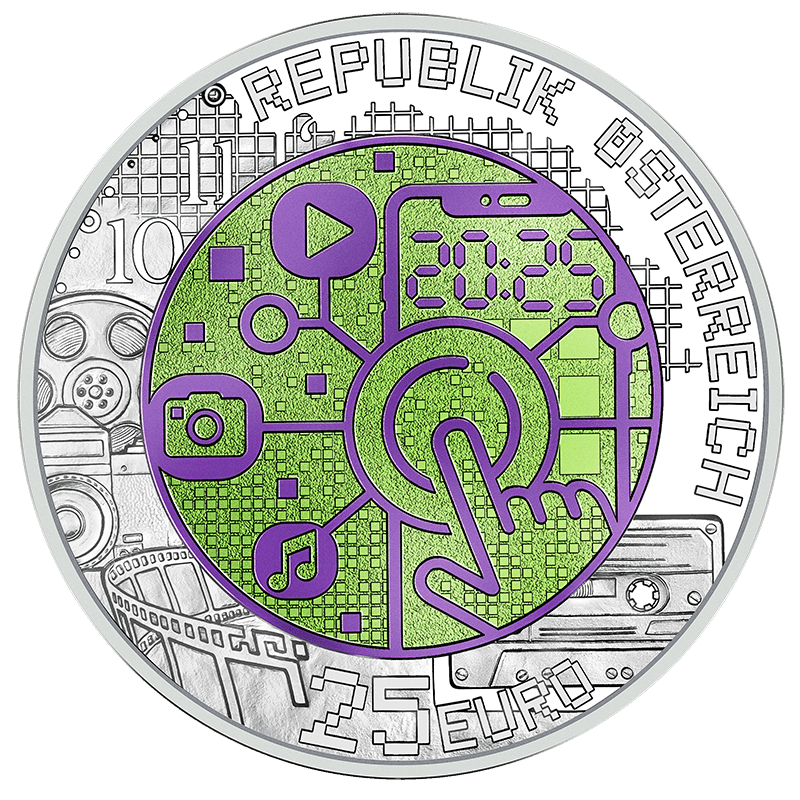Digitalisation, the 2025 edition of our groundbreaking Silver Niobium Coin, celebrates technological progress while reminding us that change is constant and shapes both our society and our future.
With the development of microprocessors and computers, an unstoppable transition began in the 1970s. The dialling of landlines and the clattering of typewriters became the workplace soundscape of yesteryear.
Today, the Internet, smartphones and social media dominate our lives as technological progress has fundamentally changed how we communicate, both privately and professionally. Companies are increasingly focused on automation and professions that did not previously exist have emerged.
But what does the future hold? Digitalisation will no doubt continue to develop until it permeates all areas of our lives even more deeply than it already does. Artificial intelligence (AI) and virtual reality are opening up countless new possibilities and these technologies are increasingly offering personalised solutions for myriad processes. The world is ever more connected and smart cities, the Internet of things (IoT), self-driving cars and digital currencies increasingly commonplace. At the same time, challenges are constantly emerging. Data protection, ethics and digital participation have to be constantly reassessed, for example, as does the importance of cyber security in an increasingly networked world.
With the Crypto stamp, Österreichische Post AG offers a stamp that is also stored as a digital image in the blockchain. This guarantees complete traceability of all former owners of the stamp or its digital image. By using blockchain technology, the Crypto stamp can of course also continue to be traded. Each physical stamp is equipped with a QR code that leads to the website of the corresponding digital image. Technically, the digital Crypto stamps are implemented as blockchain tokens in the ERC721 standard, which is supported by many blockchain applications.
Quelle: https://cryptostamp.com/faqs/#question_what_is_cs4 vom 27.1.2025
NFC stands for near field communication and is a standard for special microchips that can communicate with modern smartphones with NFC functionality. We have built the NFC chip into the Crypto stamp so that you can check the authenticity of the Crypto stamp without opening the sealed packaging.
Activate the NFC function on your smartphone. Any smartphone with NFC functionality can read the chip. Hold the Crypto stamp to your smartphone to check its authenticity. Please refer to your smartphone manual for the exact location of the NFC chip on your phone. On the details page of your Crypto stamp, you can find out whether the Crypto stamp is genuine and how often NFC verification has been used.
Quelle: https://cryptostamp.com/faqs/#what_is_nfc vom 27.1.2025
Österreichische Post AG has already launched several crypto stamps on the market. You can find more information here.
| Quality | Special Uncirculated |
| Face Value | 25 Euro |
| Diameter | 34 mm |
| Alloy | Silver Ag 900, Niobium |
| Weight | 16.50 g |

Among the most spectacular of Münze Österreich products are our innovative Silver Niobium coins.
The beauty of niobium is that colours do not need to be applied to it as they are created during the oxidation process. By means of ‘anodized oxidation’, a very thin oxide layer is produced on the coin surface and subsequent light refraction enables different colours to arise.
With each Silver Niobium coin being completely different from the last, both in terms of its colour and subject matter, it is little wonder that they have won numerous international award and are extremely popular as gifts and with coin collectors.
So, it is hardly surprising that many of them are sold out and can only be found for sale in the secondary coin market, although often at a considerable premium. We do have the last three editions still in stock, however.